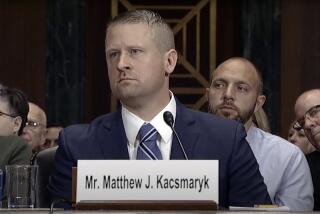Abortion-Rights Backer Reveals ‘Lie’
- Share via
WASHINGTON — In an admission that could help antiabortion forces, a leading abortion-rights advocate has revealed that he “lied” in declaring publicly that the procedure widely called “partial-birth abortion” is rare and performed largely on women whose pregnancies have gone tragically awry.
In asserting that many perfectly healthy women with healthy fetuses have the controversial procedure, Ron Fitzsimmons, executive director of the National Coalition of Abortion Providers, buoyed antiabortion lawmakers as they resumed their effort to make the procedure illegal.
After a bill outlawing the procedure passed both the House and Senate last year, President Clinton vetoed it, saying: “I came to understand that this is a rarely used procedure, justifiable as a last resort when doctors judge it necessary to save a woman’s life or to avert serious health consequences to her.”
Fitzsimmons, in an interview published in the American Medical News, said that in the course of a bitter yearlong debate on the issue, abortion-rights advocates never acknowledged that the vast majority of these procedures are performed at roughly 20 weeks of gestation on healthy fetuses and healthy mothers.
“The abortion-rights folks know it. The antiabortion folks know it. And so, probably, does everyone else,” Fitzsimmons said.
Abortion-rights advocates greeted Fitzsimmons’ stinging indictment with a furious flurry of denial, recrimination and clarification. Reiterating their claim that all late-term abortions probably account for no more than 600 of the 1.5 million abortions performed yearly, they insisted that that is a small number.
They further asserted that virtually all those abortions are performed under existing laws in 41 states that ban or greatly restrict the procedure to cases where there is a major fetal abnormality or a mother’s health or life would be jeopardized by the continuation of a pregnancy.
“If he thinks he lied, I guess that’s his problem to deal with,” Kate Michelman, president of the National Abortion and Reproductive Rights Action League, said of Fitzsimmons. “We have not.”
The barrage of charge and countercharge within the ranks of abortion-rights advocates underscores the divisions that have racked the movement in recent years. In the face of a constant stream of challenges from antiabortion lawmakers, who now hold majorities in both the House and Senate, abortion-rights advocates are finding themselves feuding over tactics and priorities with increasing frequency.
Opponents of abortion were gleeful Wednesday when news of Fitzsimmons’ interview appeared in the New York Times. “The abortion movement is based on one big lie,” said Rep. Christopher H. Smith (R-N.J.), who vowed to reintroduce the bill banning the procedure. “It is clear that even those that have defended this method of child abuse eventually have their consciences catch up with them.”
Senate Majority Leader Trent Lott (R-Miss.) also has promised to bring the bill to another vote this year, and lawmakers opposing a ban on the procedure once again scrambled to make their case.
California Democratic Sen. Barbara Boxer charged that abortion foes “want to abolish abortion one procedure at a time.” Boxer said she and other senators were prepared to pass a bill that would ban all abortions after a fetus has reached viability, if it contained exemptions for women whose life, health or future reproductive prospects would be put in jeopardy by a continued pregnancy. But abortion foes, arguing that such a bill essentially would codify the 1973 Supreme Court Roe vs. Wade decision, vehemently objected.
“We didn’t want any late-term abortions whatever,” said Boxer, referring to those performed roughly after the 26th week of gestation. “We could have walked hand in hand with the pro-life people and passed this in a nanosecond.”
Michelman and a phalanx of abortion-rights providers cautioned Wednesday that they do not know how often, or under what circumstances, the “partial-birth” abortion procedure is performed before a fetus reaches the point of viability. That point, in their view, distinguishes “late-term abortions” from all others.
Before that point of fetal viability, which comes about the 26th week of gestation, a woman’s right to an abortion is protected under Roe vs. Wade. As a result, the advocates maintained, those abortions cannot constitutionally be restricted and are not centrally tracked or reported by abortion providers.
Accordingly, Michelman said, neither abortion opponents nor abortion-rights advocates can say with confidence why and how many women are getting the “intact dilation and extraction” procedure that would have been outlawed by the bill that Clinton vetoed. “I don’t think Ron knows either,” Michelman said.
She said that in the debate over the “partial-birth” abortion ban, abortion foes purposely have blurred the distinction between procedures performed late in the second trimester, which are constitutionally protected, and “late-term” abortions, which are performed in the third trimester of pregnancy.
That, in turn, caused opponents of the bill that would have banned the “partial-birth” procedure to focus their efforts on countering the charge that healthy women in their final trimesters of pregnancy were aborting healthy fetuses.
“I wouldn’t amend anything,” Michelman said.
More to Read
Get the L.A. Times Politics newsletter
Deeply reported insights into legislation, politics and policy from Sacramento, Washington and beyond. In your inbox twice per week.
You may occasionally receive promotional content from the Los Angeles Times.











